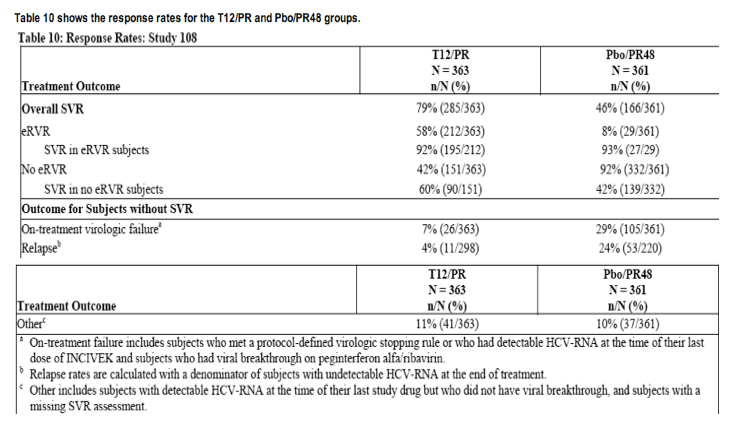| |
Telaprevir (Incivek brand name): Treatment-Naïve Adults study results
|
| |
| |
Study 108 (ADVANCE)
Study 108 was a randomized, double-blind, parallel-group, placebo-controlled, trial conducted in treatment-naïve subjects (had received no prior therapy for
HCV, including interferon or pegylated interferon monotherapy). INCIVEK was given for the first 8 weeks of treatment (T8/PR regimen) or the first
12 weeks of treatment (T12/PR regimen) in combination with Peg-IFN-alfa-2a/RBV for either 24 or 48 weeks. Subjects who had undetectable HCV-RNA at
weeks 4 and 12 (extended Rapid Virologic Response [eRVR]) received 24 weeks of Peg-IFN-alfa-2a/RBV treatment, and subjects who did not have
undetectable HCV-RNA at weeks 4 and 12 (no eRVR) received 48 weeks of Peg-IFN-alfa-2a/RBV treatment. The control regimen (Pbo/PR48) had a fixed
treatment duration, with telaprevir-matching placebo for the first 12 weeks and Peg-IFN-alfa-2a/RBV for 48 weeks.
The 1088 enrolled subjects had a median age of 49 years (range: 18 to 69); 59% of the subjects were male; 23% had a body mass index greater than or equal to 30 kg/m2; 9% were Black; 11% were Hispanic or Latino; 77% had baseline HCV-RNA levels greater than 800,000 IU/mL; 15% had bridging fibrosis; 6% had cirrhosis; 59% had HCV genotype 1a; and 40% had HCV genotype 1b.

In the T8/PR group, the overall SVR rate was 72%. The eRVR rate was 57% and the SVR rate for eRVR subjects was 87%. The SVR rate for no eRVR
subjects was 52%. More subjects in the T8/PR group experienced virologic breakthrough after Week 12 while receiving peginterferon alfa and ribavirin
alone, 16% compared to 10% in T12/PR group.
SVR rates were higher (absolute difference of at least 22%) for the T12/PR group than for the Pbo/PR48 group across subgroups by sex, age, race, ethnicity, body mass index, HCV genotype subtype, baseline HCV-RNA (less than 800,000, greater than or equal to 800,000 IU/mL), and extent of liver fibrosis.
However, there were small numbers of subjects enrolled in some key subgroups. In the T12/PR group:
· Twenty-one subjects had cirrhosis at baseline and the overall SVR in these subjects was 62% (13/21). Among subjects with cirrhosis, 43% (9/21)
achieved an eRVR and of those 78% (7/9) achieved SVR.
· Twenty-six subjects were Black/African Americans. The overall SVR among Black/African American subjects was 62% (16/26). Among these
subjects, 31% (8/26) achieved an eRVR and of those 89% (8/9) achieved SVR.
Study 111 (ILLUMINATE)
Study 111 was a randomized, open-label trial conducted in treatment-naïve subjects. The study was designed to compare SVR rates in subjects achieving
eRVR who were treated with INCIVEK for 12 weeks in combination with Peg-IFN-alfa-2a/RBV for either 24 weeks (T12/PR24 regimen) or 48 weeks
(T12/PR48 regimen).
The 540 enrolled subjects had a median age of 51 years (range: 19 to 70); 60% were male; 32% had a body mass index greater than or equal to 30 kg/m2; 14% were Black; 10% were Hispanic or Latino; 82% had baseline HCV-RNA levels greater than 800,000 IU/mL; 16% had bridging fibrosis; 11% had
cirrhosis; 72% had HCV genotype 1a; and 27% had HCV genotype 1b.
The SVR rate for all subjects enrolled in the trial was 74%. A total of 352 (65%) subjects achieved eRVR and of those 322 (60%) were randomized to 24
weeks (T12/PR24, n=162) or 48 weeks (T12/PR48, n=160) of treatment. The SVR rates were similar at 92% (T12/PR24) and 90% (T12/PR48), respectively.
Again, small numbers of subjects were enrolled in some key subgroups:
· Sixty-one (11%) of subjects had cirrhosis at baseline. Among subjects with cirrhosis, 30 (49%) achieved an eRVR: 18 were randomized to T12/PR24
and 12 to T12/PR48. The SVR rates were 67% (12/18) for the T12/PR24 group and 92% (11/12) for the T12/PR48 group.
· Blacks/African Americans comprised 14% (73/540) of study subjects. Thirty-four (47%) Black/African American subjects achieved an eRVR and
were randomized to T12/PR24 or T12/PR48. The respective SVR rates were 88% (15/17) and 94% (16/17), compared to 93% (246/265) for
Caucasians.
|
|
| |
| |
|
|
|